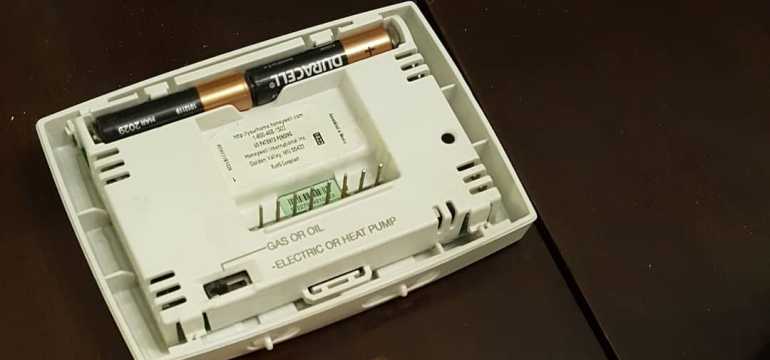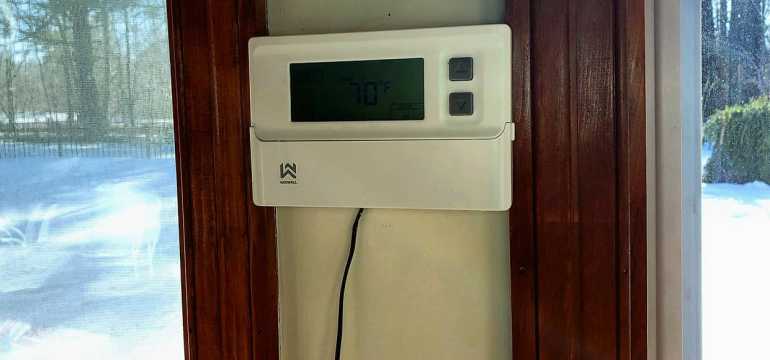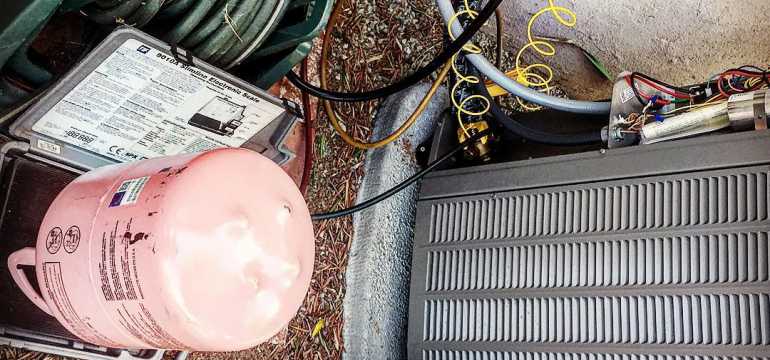You need your thermostat to work properly if you want your HVAC unit to effectively cool and heat your home. That’s why it can be a headache if you notice your thermostat going blank, then coming back on.
If your thermostat goes blank, then comes back on, it’s a sign of short cycling. This is when the HVAC unit turns off and on more frequently than it should. It can be caused by weak batteries, poor thermostat placement, dirty air filters, and several other problems.
We put together this article to help you solve this issue. Keep reading to learn more about potential causes of this problem and for guidance on how to resolve them.
Battery problems

Some HVAC units have thermostats that are powered by batteries. If the battery power runs out on your thermostat, it could lead to short cycling.
You can usually see if you have low batteries by looking at your thermostat screen. There should be some indication that the battery power is running low.
Even if you don’t see that notification, it’s probably worth starting by replacing your thermostat batteries. That way, you can at least rule out that this is the cause of your issues.
The length of time that thermostat batteries last varies significantly from unit to unit—some last for years while others only last for months.
Thermostat placement issues

Many people don’t realize that thermostat placement can impact the functioning of their HVAC systems. But it absolutely can. And a poor thermostat placement can lead to short cycling.
That’s because when you place a thermostat in or near the warmest parts of your house, it can misread your home’s temperature. That could lead to it telling your HVAC system to come on and off at the wrong times.
Here’s a list of what you should look for when scouting out the ideal location to install your thermostat:
- No direct sunlight
- No nearby air vents
- Away from windows and doors
- About 52 – 60 inches above the floor
The height piece is important because warm air rises. So placing a thermostat either too high or too low could cause inaccurate readings. It’s also easier to bump the thermostat when it’s installed too low.
Failing thermostat
You may also be experiencing this issue because you have a faulty thermostat. It could be caused by a loose wire, a blown fuse, or something else.
Unfortunately, the only way to figure this out is to call out an HVAC maintenance worker to take a look. They can tell you whether you need to replace your thermostat or if repairs will suffice.
It isn’t always easy to tell if your thermostat is failing. But here are the three most common signs:
- Your HVAC unit doesn’t turn on
- Your thermostat keeps losing the settings you program
- The thermostat doesn’t respond to changes in settings
Wrong unit size
Buying an HVAC unit that’s too large for your home can also lead to short cycling. That’s because when a system is too large, it leads to uneven air distribution.
When you have uneven air distribution, it can cause the room with your thermostat to warm or cool faster than other parts of the house. That may lead to your HVAC unit turning on and off more frequently than it should.
There are lots of signs that can tell you that your HVAC unit is the wrong size. We’ll cover the major ones below.
- Your HVAC unit is always running: If your HVAC unit always runs, then it’s probably too small for your home. That’s because if it’s always running, that means it’s struggling to keep your home at the desired temperature. This can lead to higher energy bills than you should be getting. Because the HVAC unit is needing to constantly use power to achieve your desired temperature.
- It restarts more than it should: When an HVAC unit turns on and off again more than it should, it could be too large for your home. This problem indicates that the system is reaching the desired temperature too quickly. And when that happens, the HVAC unit can start wearing out faster. That’s because starting and stopping the unit very often can cause wear and tear damage.
- You constantly need repairs: You shouldn’t have to repair your HVAC unit all the time. If you’re consistently having to call a repair person out, that could be a sign your unit is improperly sized. Most HVAC units are designed to last between 10 and 15 years. You’ll obviously need to maintain yours. And minor repairs might be necessary from time to time. But constant repairs shouldn’t need to happen.
- You’re getting humid air: Humid air coming from your vents can be a sign that your HVAC system is too large. That’s because large systems will heat and cool your home too quickly. And when that happens, they don’t stay on long enough to dehumidify the air.
☆ How to fix the problem
The only real solution for an improperly sized HVAC unit is to replace the system, unfortunately. Otherwise, these types of problems are just going to keep happening.
HVAC unit losing refrigerant

Your air conditioner or heat pump uses refrigerant to cool down your home. It does this by moving the refrigerant around a closed loop.
That loop goes from outside to inside and back again to cool down your air. It’s a process that’s called the refrigeration cycle.
Your HVAC unit shouldn’t ever need new refrigerant added to it. But yours might if it has a refrigerant leak. This can lead to short cycling and a thermostat that repeatedly goes on and off.
With that in mind, here are some of the signs of a refrigerant leak to keep an eye out for.
- High electric bills: When your energy bills are higher than normal, that can indicate a refrigerant leak. This is because your system may be working harder to accommodate for the refrigerant that it’s losing.
- HVAC unit takes too long to cool or heat your home: When HVAC units lose refrigerant, they also lose the ability to cool or heat your home in an efficient way. So if your HVAC system is losing efficiency, that could also indicate it has a refrigerant leak.
- There’s more humidity in your home than usual: HVAC units are really efficient at dehumidifying your home. Most modern ones can do so in about 15 minutes. But if your system struggles to achieve this, then it could be a sign of leaking refrigerant.
- Your evaporator coil is frozen: This is one of the most common signs of a refrigerant leak. When you see ice crystals on your evaporator coil, you probably have a leak.
- Your HVAC unit is leaking water: An HVAC unit that leaks water often does so because its evaporator coil gets frozen and then melts. So this could also be a sign that your refrigerant is leaking.
- You hear hissing noises: Hissing noises can also be caused by a leaking refrigerant. You may even hear gurgling noises because of this problem if the issue gets severe enough.
- There’s low airflow: HVAC units that provide less airflow than normal often do so because of a leaking refrigerant problem. That’s because they aren’t able to cool your home as efficiently without the proper amount of refrigerant.
- There are small bubbles in the evaporator coil: If you look at your evaporator coil, you might also see small bubbles around it. These are signs of tiny refrigerant leaks.
☆ How to fix this problem
Unfortunately, you can’t just add refrigerant to your system if you have a leak. You would have to continue doing this forever since the leak would never get fixed.
That’s why the only real solution is calling an HVAC technician. They can help you find and fix leaks. Then they can top up your refrigerant to get your HVAC unit back to normal.
Dirty air filters
Dirty air filters are another potential cause of short cycling. That’s because when air filters get clogged, they can produce airflow restrictions.
When airflow is restricted, it has the potential to freeze your evaporator coil. And that will cause your system to keep turning off and on.
That’s why it’s really important to clean and replace your air filters on a consistent schedule. It’s a good idea to get in the habit of looking at them once a month. This is especially important to do if you live in a dusty area.
Can short cycling damage your furnace and AC?
If you’re experiencing short cycling, you might worry about it damaging your HVAC unit. There are a few ways that this can impact your system.
- More wear and tear: When a system turns off and on more often than it should, it also wears down faster than it should. That happens because the parts have more stress placed on them than they should.
- Higher energy bills: Short cycling also tends to cause higher energy bills. This problem has that effect because your HVAC unit is turning off and on more frequently than normal. And that causes it to use more power than it usually needs.
- Uneven temperatures: You’re also likely to experience rooms with uneven temperatures when you have short cycling. This is another reason why fixing the problem as soon as possible is a smart decision.
- What to Do if Your House Smells Like Gas but There’s No Leak - February 6, 2023
- Why Is There a Burning Smell Coming From My Vents? - August 16, 2022
- How to Remove the Musty Smell From Your Air Conditioner - August 16, 2022

